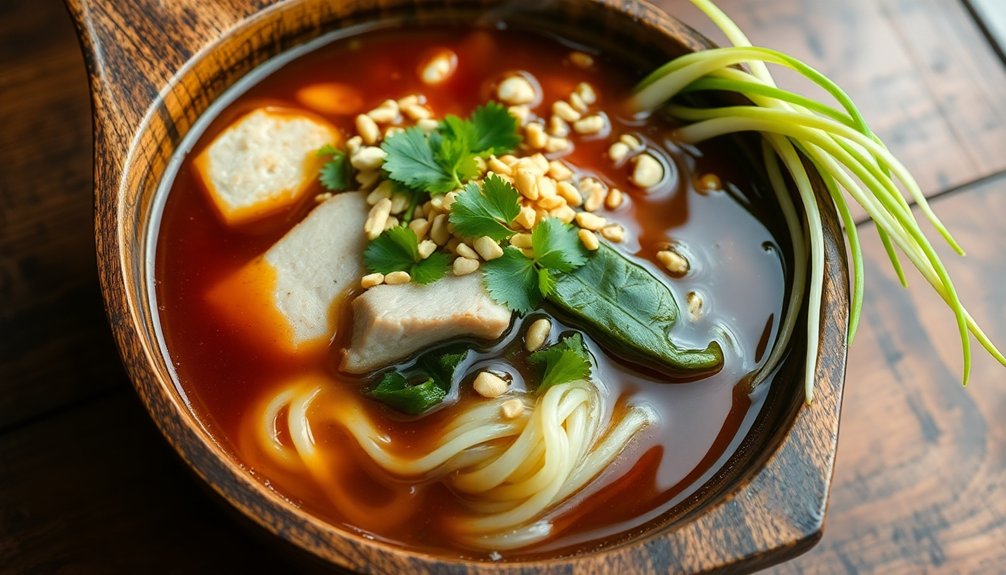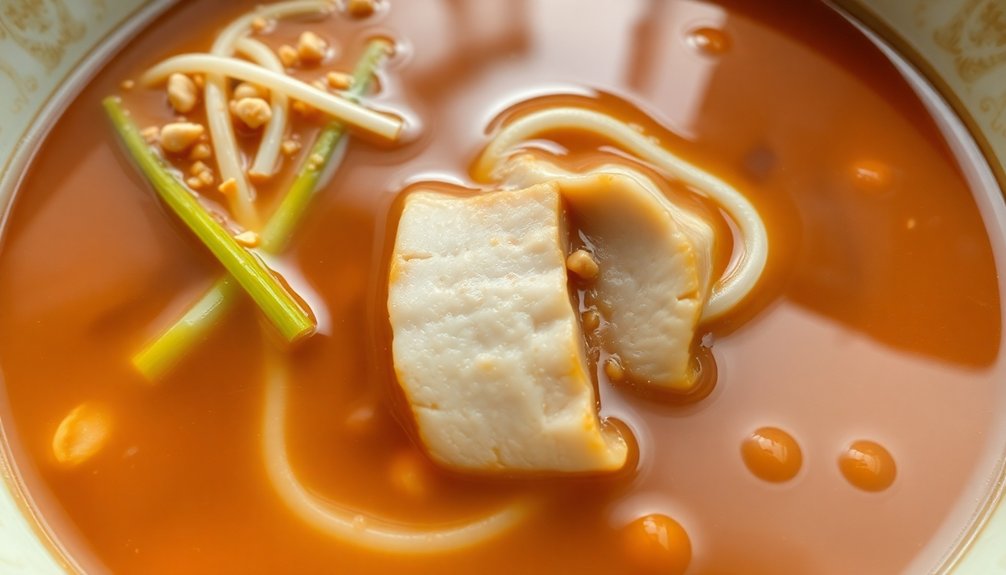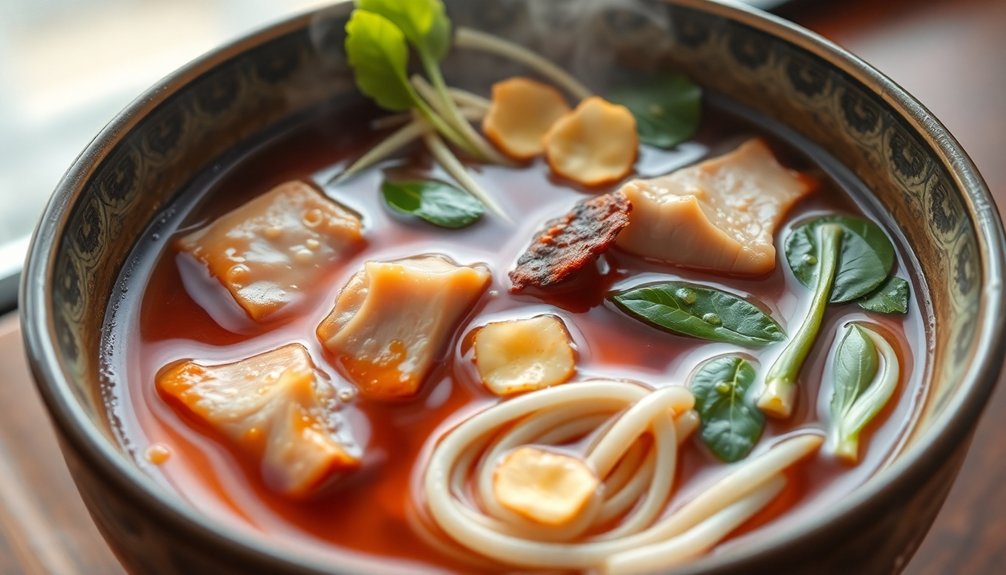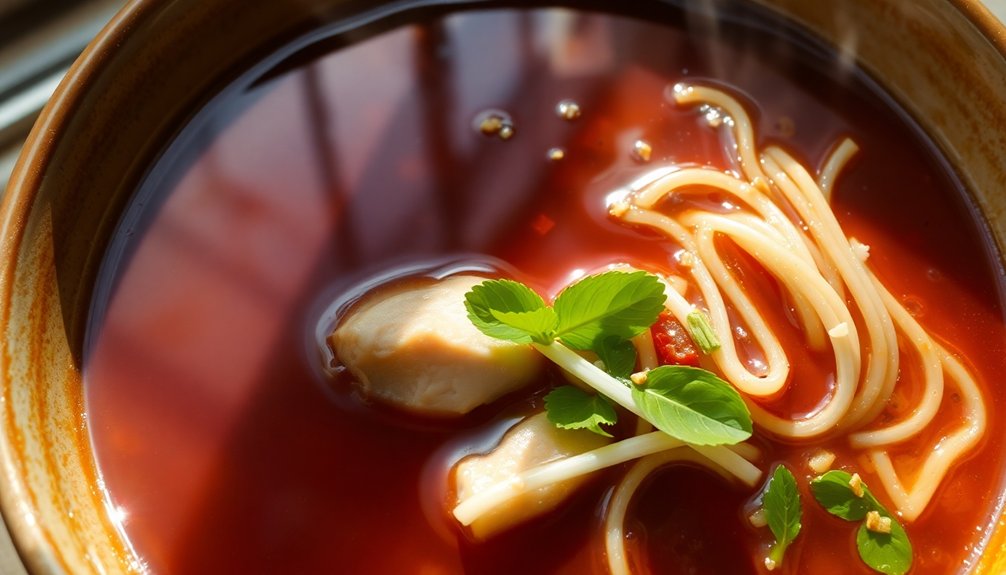Guay Tiew Reua - Boat Noodle Soup With Rich Broth
You'll discover a legendary Thai dish that originated in Bangkok's canals during the late 19th century, where vendors served intensely flavored noodle soup from wooden boats. The rich broth combines pork or beef bones, aromatic spices, and traditional seasonings, while tender rice noodles, meat slices, and fresh herbs create layers of authentic flavor. This beloved street food staple tells a story of Thailand's culinary heritage that invites you to explore its depths.
Key Takeaways
- Guay Tiew Reua is a traditional Thai noodle soup served from boats, featuring rich broth made with pork or beef bones.
- The signature dark broth combines sweet, spicy, and savory flavors using soy sauce, palm sugar, and aromatic spices.
- Main components include rice noodles, tender meat slices, meatballs, bean sprouts, and morning glory vegetables.
- The dish often incorporates pork blood for richness, topped with crispy pork rinds, fresh herbs, and green onions.
- Slow-simmered broth and layered seasonings create deep flavors characteristic of authentic Thai boat noodles.
History
During the reign of King Rama V in the late 19th century, boat noodles emerged along Bangkok's extensive canal network as vendors paddled their small wooden boats, serving steaming bowls of noodle soup to locals.
These resourceful vendors mastered the art of preparing and serving noodles in cramped spaces, creating smaller portions that you could easily consume while seated in their boats.
You'll find that boat noodles have become an iconic part of Thai cuisine, embodying the adaptability and ingenuity of Thai street food culture.
The dish's cultural significance grew as Bangkok's waterways served as the city's main transportation routes.
Even as most canals have been filled to create roads, you can still enjoy this historic dish in specialized restaurants that preserve the traditional small serving size and authentic flavors.
Recipe

Ingredients:
- Rice noodles
- Pork or beef slices
- Pork or beef meatballs
- Pork blood (optional)
- Bean sprouts
- Morning glory
- Green onions
- Cilantro
- Crispy pork rinds
Broth:
- Pork or beef bones
- Garlic
- Coriander root
- Black peppercorns
- Star anise
- Cinnamon stick
- Soy sauce
- Dark soy sauce
- Fish sauce
- Palm sugar
- Chili powder
Instructions:
1. Simmer bones with garlic, coriander root, peppercorns, star anise, and cinnamon for 2-3 hours to make broth.
2. Strain broth and season with soy sauces, fish sauce, palm sugar, and chili powder.
3. Cook rice noodles according to package instructions.
4. Blanch meat slices and meatballs in boiling water.
5. Briefly cook bean sprouts and morning glory.
6. Assemble in bowl:
- Place cooked noodles
- Add meat and meatballs
- Pour hot broth
- Add pork blood if using
- Top with vegetables
- Garnish with green onions, cilantro, and pork rinds
7. Serve with condiments:
- Chili flakes
- Sugar
- Fish sauce
- Vinegar
Cooking Steps

You'll want to start by preparing fresh rice noodles and creating a rich pork broth infused with star anise, cinnamon, and galangal - essential elements that give this Thai boat noodle soup its authentic character.
Next, you'll season thin slices of pork with soy sauce and white pepper before combining them with the steaming broth and tender noodles in your serving bowl.
Finally, you'll crown your boat noodles with a generous handful of fresh Thai basil, bean sprouts, and morning glory greens, just as vendors have done for generations along Bangkok's canals.
Step 1. Prepare Fresh Rice Noodles
To prepare authentic Thai rice noodles for boat noodle soup, first soak the dried rice noodles (sen lek) in room temperature water for 30 minutes until they become pliable.
- Bring a large pot of water to a rolling boil, then add your soaked noodles and cook for 2-3 minutes until they're just tender but still have a slight bite - you'll want them al dente.
- Quickly drain the noodles in a colander and rinse under cold water to stop the cooking process and prevent them from sticking together.
- Toss the noodles with a small amount of oil to keep them separated and prevent clumping.
- If you're not using them immediately, store the cooked noodles in portions by spreading them on a lightly oiled plate at room temperature for up to 2 hours.
Step 2. Make Rich Pork Broth
Creating the rich pork broth base forms the heart and soul of authentic Guay Tiew Reua, a street food staple that originated from Thai-Chinese vendors who paddled their boats along Bangkok's canals.
Start by blanching pork bones in boiling water for 5 minutes to remove impurities. Transfer the cleaned bones to a large pot with fresh water and bring to a gentle simmer.
Add white peppercorns, garlic, coriander roots, and rock sugar. Maintain a low heat, skimming any foam that rises to the surface. You'll want to simmer for at least 3 hours until the broth develops its signature flavor depth.
Traditional boat noodle vendors would start their broths before dawn, letting them simmer until opening time. For extra richness, some add pork blood during the final hour of cooking.
Step 3. Season the Meat
Marinating tender slices of pork is essential for developing the complex flavors in Guay Tiew Reua.
Traditional Thai seasoning techniques create the perfect flavor balance that street vendors have mastered over generations on Bangkok's canals. You'll want to prepare your meat with care, following these time-honored steps.
- Mix thin-sliced pork with white pepper, dark soy sauce, and a splash of fish sauce.
- Add crushed garlic, a pinch of palm sugar, and coriander root for aromatic depth.
- Massage the seasonings into the meat gently with your hands for even distribution.
- Let the meat marinate for at least 30 minutes at room temperature, allowing the flavors to penetrate.
The properly seasoned meat will become tender and flavorful, ready to complement the rich broth you've prepared.
Step 4. Combine Broth and Noodles
Assembling your boat noodle soup requires careful layering of ingredients to achieve the authentic street food experience.
Start by placing your choice of noodle varieties - sen lek (rice noodles), sen mee (vermicelli), or sen yai (wide rice noodles) - in a preheated bowl. They should be just cooked but still firm.
Pour the piping hot broth over the noodles, ensuring the broth consistency is rich and dark from the blood and spices.
Add your seasoned meat slices, meatballs, and morning glory.
Top with crispy pork rinds, Chinese celery leaves, and green onions.
For the final authentic touch, you'll want to serve traditional condiments like dried chili flakes, sugar, fish sauce, and vinegar on the side, allowing diners to adjust flavors to their preference.
Step 5. Garnish With Fresh Herbs
Fresh herbs bring essential authenticity to guay tiew reua, transforming it from a simple noodle soup into a vibrant Thai street food experience. The herb benefits extend beyond flavor, offering aromatic complexity and traditional medicinal properties that Thai street vendors have relied on for generations.
- Sprinkle fresh cilantro leaves and stems across the surface, enhancing the soup's earthy undertones.
- Add Thai holy basil leaves, which release their distinct peppery aroma when they meet the hot broth.
- Scatter chopped green onions for a mild allium bite and visual appeal.
- Include optional garnish options like bean sprouts, Chinese celery leaves, or saw leaf herb.
These fresh herbs aren't just garnishes - they're integral components that complete the dish's flavor profile, just as boat noodle vendors have served it along Bangkok's canals for decades.
Cooking Tips

Several key techniques guarantee an authentic boat noodle soup experience.
You'll want to simmer the broth slowly, allowing the pork and beef bones to release their deep flavors - a technique Thai boat vendors have used for generations.
When adjusting the soup consistency, remember to strain the broth thoroughly to achieve that signature clarity that's essential to Guay Tiew Reua.
To master the flavor balance, you'll need to layer the seasonings gradually.
Start with the soy sauce and fish sauce base, then add palm sugar to counter the saltiness.
Don't rush adding the blood cubes - they should be incorporated just before serving to maintain their texture.
If you're seeking that distinctive street-food taste, make sure you're using Thai holy basil rather than regular basil.
Final Thoughts

While mastering the techniques of Guay Tiew Reua takes practice, the reward of creating this iconic Thai street food at home is worth every effort.
This humble boat noodle soup carries deep cultural significance, originating from Bangkok's canal-side vendors who'd serve steaming bowls from their wooden vessels.
Today, you'll find flavor variations across Thailand's regions, each telling its own culinary story.
- You're connecting with Thailand's waterway heritage through every spoonful of this rich, complex broth.
- You're preserving a tradition that dates back to the early 20th century when boats were Bangkok's primary mode of commerce.
- You're experiencing the same harmonious blend of sweet, spicy, and savory notes that locals have enjoyed for generations.
- You're mastering a dish that represents the resourcefulness of Thai street food culture.
Frequently Asked Questions
How Long Can Boat Noodle Soup Be Stored in the Refrigerator?
As sure as the tide rises, you'll want to follow proper broth preservation methods. Store your soup in the refrigerator for 3-4 days, keeping noodles separate to maintain their texture.
What Are the Best Substitute Noodles for Authentic Boat Noodle Soup?
You'll find rice vermicelli or thin rice noodles are your best traditional choice. For alternative noodle options, try glass noodles or gluten-free substitutes like shirataki noodles while maintaining authenticity.
Is Boat Noodle Soup Traditionally Eaten for Breakfast or Dinner?
You'll find boat noodles served throughout the day in Thailand, but traditional customs favor enjoying them for lunch. Street vendors historically began serving around mid-morning and continued until their broth ran out.
Why Are Boat Noodle Portions Typically Served Small in Thailand?
You'll find small portions are tied to noodle history when vendors sold from boats - they needed portion control to prevent spills while rowing and serving customers along Bangkok's busy canals.
Can Boat Noodle Soup Be Made Vegetarian While Maintaining Authentic Flavor?
You can use vegetarian substitutes like mushroom broth and soy sauce, but you'll miss authentic flavors that come from pork blood and meat, which are essential to traditional boat noodles.
